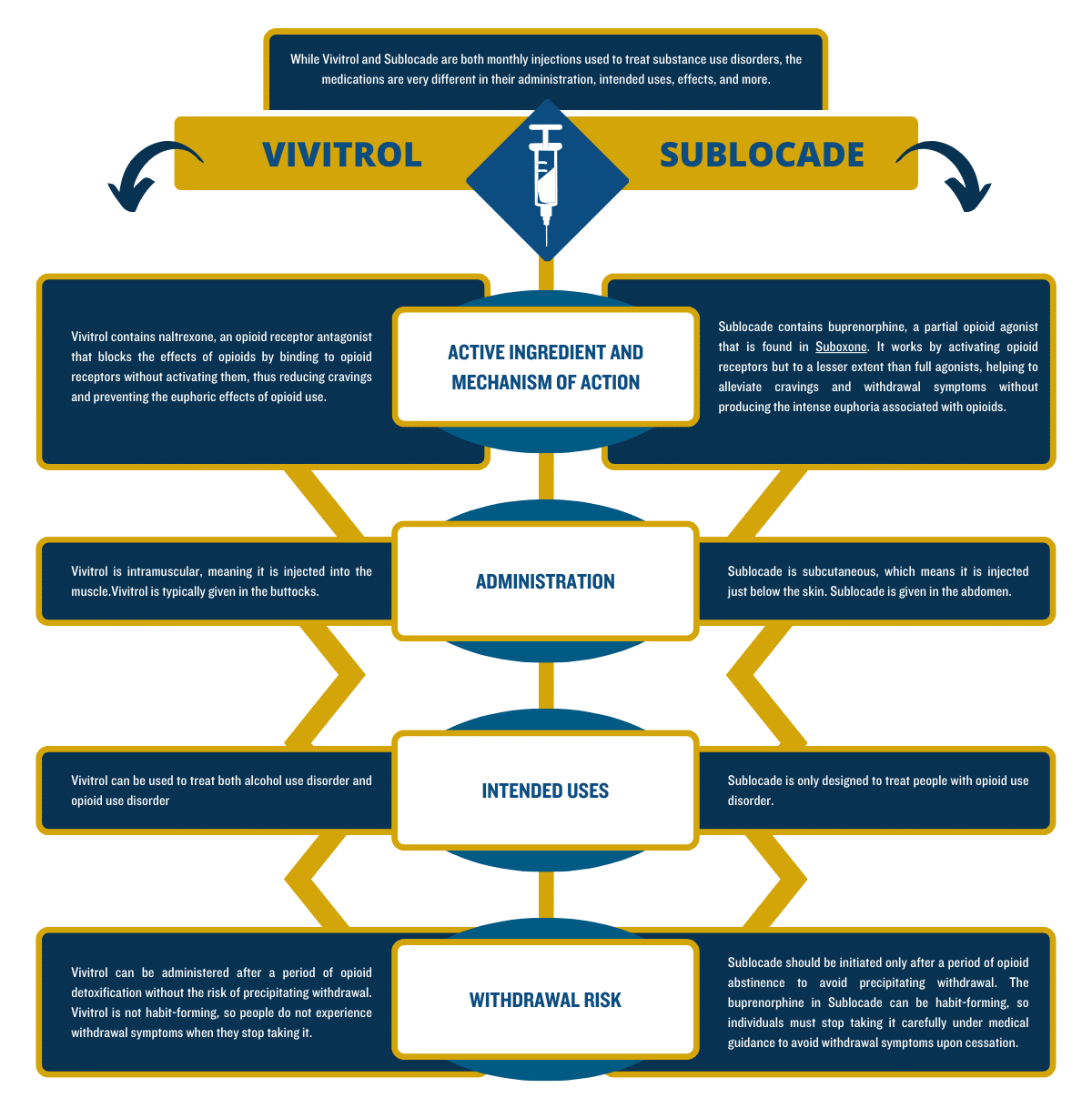Vivitrol vs Sublocade: An In-Depth Comparison

Medically Verified: 2/1/24
Medical Reviewer
Chief Editor

All of the information on this page has been reviewed and verified by a certified addiction professional.
One of the most popular approaches to treating addiction is known as medication-assisted treatment (MAT), a comprehensive approach that combines certain medications with counseling and behavioral therapy. Two medications that may be used in MAT include Vivitrol and Sublocade. While these two medications appear similar because they come in injection form and can be used to treat opioid use disorder, there are significant differences between Vivitrol and Sublocade that you should be aware of if you are considering MAT for yourself or a loved one.
What is Vivitrol?

Vivitrol is a brand name for an extended-release injectable form of naltrexone, which is a medication used in the treatment of alcohol and opioid dependence. Naltrexone is an opioid receptor antagonist, meaning it blocks the effects of opioids in the brain. Vivitrol is typically administered once a month via an intramuscular injection. The intramuscular injection is often administered in the buttocks.
Vivitrol Uses
While most other MAT medications are used to treat either alcohol use disorder or opioid use disorder, but not both, Vivitrol is unique in the way it can be used to help people who suffer from both conditions. It was approved by the U.S. Food and Drug Administration (FDA) for alcohol dependence in 2006 and for opioid dependence in 2010.
For alcohol dependence, it helps reduce the desire to drink alcohol by helping stabilize brain chemistry and reducing cravings. For opioid dependence, it works by blocking the effects of opioids, reducing cravings, and preventing the euphoric effects that can lead to relapse.
Vivitrol is most effective when combined with a complete treatment program consisting of counseling, behavioral therapy, peer support, and aftercare.
Vivitrol Side Effects
Vivitrol, like any medication, can have side effects. It’s important to note that not everyone will experience these side effects, and the severity of side effects can vary from person to person. If you are prescribed Vivitrol, your healthcare provider will closely monitor you for any adverse reactions.
The most common side effect of Vivitrol is injection site reactions. This may include pain, swelling, bruising, or redness at the injection site. These symptoms are usually mild and temporary, subsiding in the days following the injection.
Other common side effects of Vivitrol may include:
- Nausea
- Vomiting
- Diarrhea
- Headache
- Muscle cramps
- Joint pain
- Insomnia
- Dizziness
- Nervousness
- Irritability
- Reduced appetite
- Depression
In rare cases, allergic reactions may occur, and emergency medical attention should be sought if you experience symptoms such as difficulty breathing, swelling of the face, lips, or tongue, or severe rash.
What is Sublocade?

Sublocade is a brand name for an extended-release injectable form of buprenorphine, which is a medication used in the treatment of opioid dependence. Buprenorphine is a partial opioid agonist, meaning it binds to the same receptors in the brain as opioids but produces a milder effect, helping to reduce cravings and withdrawal symptoms without causing the intense euphoria associated with full opioid agonists like heroin or oxycodone.
Sublocade is a subcutaneous injection, meaning it is administered just below the skin, usually in the abdomen. After it is injected, the medication forms a solid, gel-like substance called a depot (dee-poh) that continuously releases a steady dose of buprenorphine for up to one month. This extended-release formulation is designed to help with medication adherence and reduce the risk of relapse by eliminating the need for daily medication and maintaining steady levels of buprenorphine in the body.
Sublocade Uses
Sublocade is primarily indicated for the treatment of moderate to severe opioid use disorder in adults who have initiated treatment with a transmucosal (absorbed through the mucous membranes) buprenorphine-containing product. This means individuals must take oral buprenorphine for at least seven days before starting the medication.
Sublocade was approved by the FDA in 2017. Like Vivitrol and other MAT medications, Sublocade is intended to be used in tandem with a comprehensive treatment program that includes counseling, behavioral therapy, and peer support.
Sublocade Side Effects
Similar to Vivitrol, the most common side effects of Sublocade are injection-site reactions including pain, swelling, redness, itching, and irritation at the injection site. Injection site reactions are normal and generally subside within a few days.
Other common side effects of Sublocade include:
- Digestive system issues (nausea, constipation, vomiting)
- Tiredness
- Headache
- Insomnia
- Withdrawal symptoms
- Liver issues
- Depression
Before starting Sublocade or any medication, discuss your medical history, including any existing medical conditions or medications you are taking, with your healthcare provider.
What are the Differences Between Vivitrol and Sublocade?

While Vivitrol and Sublocade are both monthly injections used to treat substance use disorders, the medications are very different in their administration, intended uses, effects, and more.
Active Ingredient and Mechanism of Action
The primary difference between Vivitrol and Sublocade is the medications in them and the way that they work. Vivitrol contains naltrexone, an opioid receptor antagonist that blocks the effects of opioids by binding to opioid receptors without activating them, thus reducing cravings and preventing the euphoric effects of opioid use.
Sublocade, on the other hand, contains buprenorphine, a partial opioid agonist that is found in Suboxone. It works by activating opioid receptors but to a lesser extent than full agonists, helping to alleviate cravings and withdrawal symptoms without producing the intense euphoria associated with opioids.
Administration
Both Vivitrol and Sublocade are administered as monthly injections, however, Vivitrol is intramuscular, meaning it is injected into the muscle. Sublocade is subcutaneous, which means it is injected just below the skin. Vivitrol is typically given in the buttocks and Sublocade is given in the abdomen.
Intended Uses
Another major difference between the two drugs is their approved uses. While Vivitrol can be used to treat both alcohol use disorder and opioid use disorder, Sublocade is only designed to treat people with opioid use disorder.
Withdrawal Risk
Vivitrol can be administered after a period of opioid detoxification without the risk of precipitating withdrawal. However, Sublocade should be initiated only after a period of opioid abstinence to avoid precipitating withdrawal. Additionally, Vivitrol is not habit-forming, so people do not experience withdrawal symptoms when they stop taking it. On the other hand, the buprenorphine in Sublocade can be habit-forming, so individuals must stop taking it carefully under medical guidance to avoid withdrawal symptoms upon cessation.
Explore Your Treatment Options Today
At Carolina Center for Recovery, we’re dedicated to helping clients find the recovery solutions that work for them. Whether you’re interested in medication-assisted treatment (MAT) or would like to discuss your other treatment options, our team is here to help. Call today to get started with a confidential, risk-free assessment.

